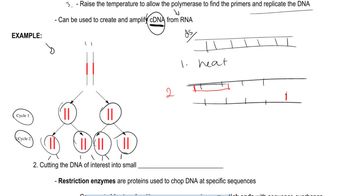Most of the techniques described in this chapter (blotting, cloning, PCR, etc.) are dependent on hybridization (annealing) between different populations of nucleic acids. Length of the strands, temperature, and percentage of GC nucleotides weigh considerably on hybridization. Two other components commonly used in hybridization protocols are monovalent ions and formamide. A formula that takes monovalent Na⁺ ions ((M[Na⁺]) and formamide concentrations into consideration to compute a Tₘ (temperature of melting) is as follows:
Tₘ=81.5+16.6(log M[Na+])+0.41(%GC)−0.72(%formamide)
For the following concentrations of Na⁺ and formamide, calculate the Tₘ. Assume 45% GC content.
[Na⁺] % Formamide
0.825 20
0.825 40
0.165 20
0.165 40
In humans, congenital heart disease is a common birth defect that affects approximately 1 out of 125 live births. Using reverse transcription PCR (RT-PCR) Samir Zaidi and colleagues [(2013) Nature 498:220.223] determined that approximately 10 percent of the cases resulted from point mutations, often involving histone function. To capture products of gene expression in developing hearts, they used oligo(dT) in their reverse transcription protocol.
Compared with oligo(dT) primers, a pool of random sequence primers requires a trickier assessment of annealing temperature. Why?
 Verified step by step guidance
Verified step by step guidance
Verified Solution
Key Concepts
Reverse Transcription PCR (RT-PCR)

Oligo(dT) Primers vs. Random Sequence Primers

Annealing Temperature in PCR

Most of the techniques described in this chapter (blotting, cloning, PCR, etc.) are dependent on hybridization (annealing) between different populations of nucleic acids. Length of the strands, temperature, and percentage of GC nucleotides weigh considerably on hybridization. Two other components commonly used in hybridization protocols are monovalent ions and formamide. A formula that takes monovalent Na⁺ ions ((M[Na⁺]) and formamide concentrations into consideration to compute a Tₘ (temperature of melting) is as follows:
Tₘ=81.5+16.6(log M[Na+])+0.41(%GC)−0.72(%formamide)
Given that formamide competes for hydrogen bond locations on nucleic acid bases and monovalent cations are attracted to the negative charges on nucleic acids, explain why the Tₘ varies as described in part (a).
In humans, congenital heart disease is a common birth defect that affects approximately 1 out of 125 live births. Using reverse transcription PCR (RT-PCR) Samir Zaidi and colleagues [(2013) Nature 498:220.223] determined that approximately 10 percent of the cases resulted from point mutations, often involving histone function. To capture products of gene expression in developing hearts, they used oligo(dT) in their reverse transcription protocol.
How would such a high %T in a primer influence annealing temperature?
In humans, congenital heart disease is a common birth defect that affects approximately 1 out of 125 live births. Using reverse transcription PCR (RT-PCR) Samir Zaidi and colleagues [(2013) Nature 498:220.223] determined that approximately 10 percent of the cases resulted from point mutations, often involving histone function. To capture products of gene expression in developing hearts, they used oligo(dT) in their reverse transcription protocol.
If one were interested in comparing the quantitative distribution of gene expression in say, the right and left side of a developing heart, how might one proceed using RT-PCR?
The U.S. Department of Justice has established a database that catalogs PCR amplification products from short tandem repeats of the Y chromosome (Y-STRs) in humans. The database contains polymorphisms of five U.S. ethnic groups (African-Americans, European Americans, Hispanics, Native Americans, and Asian-Americans) as well as the worldwide population.
For forensic applications, the probability of a 'match' for a crime scene DNA sample and a suspect's DNA often culminates in a guilty or innocent verdict. How is a 'match' determined, and what are the uses and limitations of such probabilities?
The U.S. Department of Justice has established a database that catalogs PCR amplification products from short tandem repeats of the Y chromosome (Y-STRs) in humans. The database contains polymorphisms of five U.S. ethnic groups (African-Americans, European Americans, Hispanics, Native Americans, and Asian-Americans) as well as the worldwide population.
Given that STRs are repeats of varying lengths, for example (TCTG)₉₋₁₇ or (TAT)₆₋₁₄, explain how PCR could reveal differences (polymorphisms) among individuals. How could the Department of Justice make use of those differences?
